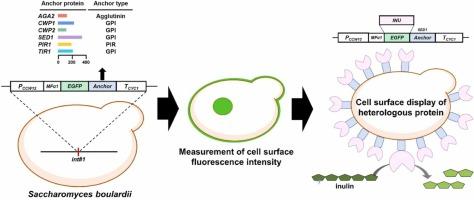Engineering Saccharomyces boulardii for cell surface display of heterologous protein
IF 4.1
2区 生物学
Q2 BIOTECHNOLOGY & APPLIED MICROBIOLOGY
引用次数: 0
Abstract
Saccharomyces boulardii and Saccharomyces cerevisiae share over 99 % genetic similarity yet exhibit distinct metabolic traits. While the cell surface display system of S. cerevisiae is well-documented, the equivalent system in S. boulardii has yet to be fully characterized. This study investigates the cell surface display system of S. boulardii for the expression of a heterologous protein using different anchor proteins. Six strains expressing the enhanced green fluorescent protein (Egfp) and an anchor protein as a fusion protein were constructed to visualize the cell surface display system. Then a heterologous endo-inulinase protein was expressed with selected anchor proteins through fluorescence intensity comparison. Analysis by fluorescence microscopy revealed that the anchor protein Sed1 exhibited the highest fluorescence intensity. Furthermore, expressed selected anchor proteins and heterologous protein, endo-inulinase, the engineered strain could degrade and consume almost inulin in 72 h. Through endo-inulinase expression, we confirmed that not only Egfp but also heterologous protein is well expressed, and we successfully built an S. boulardii cell surface display system.

改造布拉氏酵母菌,使其在细胞表面显示异源蛋白。
布拉氏酵母菌(Saccharomyces boulardii)和酿酒酵母菌(Saccharomyces cerevisiae)的基因相似度超过 99%,但却表现出不同的代谢特征。虽然酿酒酵母的细胞表面显示系统已被充分记录,但布拉氏酵母的等效系统尚未被完全描述。本研究调查了布拉氏酵母菌利用不同锚蛋白表达异源蛋白的细胞表面展示系统。研究人员构建了六株表达增强型绿色荧光蛋白(Egfp)和锚蛋白融合蛋白的菌株,以观察细胞表面显示系统。然后,通过荧光强度比较,用选定的锚蛋白表达异源内胰蛋白酶蛋白。荧光显微镜分析表明,锚蛋白 Sed1 的荧光强度最高。此外,表达了所选的锚蛋白和异源蛋白--内切菊粉酶的工程菌株能在 72 小时内降解并消耗掉几乎所有菊粉。通过内胰蛋白酶的表达,我们证实了不仅是 Egfp,异源蛋白也得到了很好的表达,并成功构建了布拉氏酵母菌细胞表面展示系统。
本文章由计算机程序翻译,如有差异,请以英文原文为准。
求助全文
约1分钟内获得全文
求助全文
来源期刊

Journal of biotechnology
工程技术-生物工程与应用微生物
CiteScore
8.90
自引率
2.40%
发文量
190
审稿时长
45 days
期刊介绍:
The Journal of Biotechnology has an open access mirror journal, the Journal of Biotechnology: X, sharing the same aims and scope, editorial team, submission system and rigorous peer review.
The Journal provides a medium for the rapid publication of both full-length articles and short communications on novel and innovative aspects of biotechnology. The Journal will accept papers ranging from genetic or molecular biological positions to those covering biochemical, chemical or bioprocess engineering aspects as well as computer application of new software concepts, provided that in each case the material is directly relevant to biotechnological systems. Papers presenting information of a multidisciplinary nature that would not be suitable for publication in a journal devoted to a single discipline, are particularly welcome.
 求助内容:
求助内容: 应助结果提醒方式:
应助结果提醒方式:


